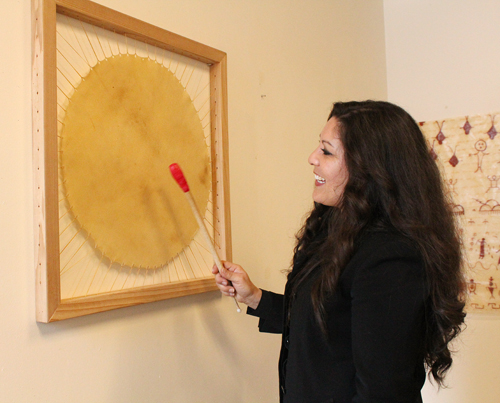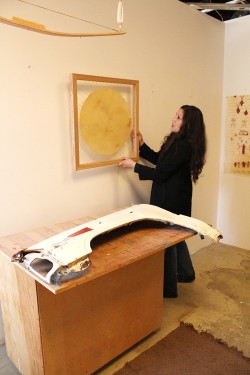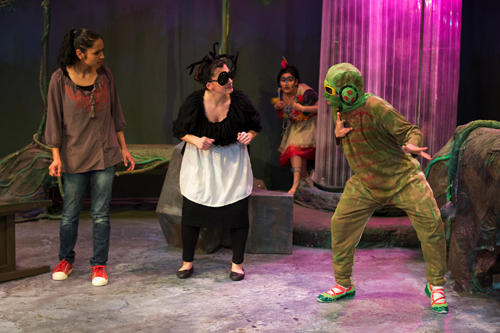Portland State Master of Fine Arts candidate Rochelle Kulei Nielsen’s studio is tucked into the heart of the university’s Art Building. The space is alive with the toil of aspiring graduate students. Nielson leads us into her corner studio, boasting artwork in a variety of media and styles, where she relates her journey as a contemporary Native American artist.
Rediscovering native roots

Portland State Master of Fine Arts candidate Rochelle Kulei Nielsen’s studio is tucked into the heart of the university’s Art Building. The space is alive with the toil of aspiring graduate students. Nielson leads us into her corner studio, boasting artwork in a variety of media and styles, where she relates her journey as a contemporary Native American artist.
Nielsen’s graduate exhibition, titled Deyaipe mu’bii, will be on view at PSU’s Autzen Gallery from April 16 through April 24. There will be a reception April 21, and a lecture with Nielson April 17.
Nielsen, who began her artistic career after leaving the pursuit of a nursing degree, will be showing a mixed media installation focusing on Native Americans’ loss of language and culture. Her artwork weaves together a range of traditional Shoshone elements, from bead-work to narrative legends.

The centerpiece of her exhibition is a gutted pickup truck dressed with rust and beads, its interior upholstered with a Shoshone tale about a coyote seeking wings. In addition, Nielsen will display works depicting her lost language and a wall-mounted rawhide drum played with wet pigment.
As I sat with Nielsen, she discussed her work, her inspirations and her hopes for the future.
Vanguard: How did you get your start? How did your initial artistic inspirations come together?
Rochelle Kulei Nielsen: I’ve always been creative, but I never did art in my early life. It started much later. In the native culture, we learn to rely on a sort of spiritual intuition. I learned as a young girl to listen for what I’m supposed to do, and I could feel it, hear it. That’s how I came to be here.
VG: When did you get started with your pursuit of art? When did you make the jump from a nursing degree to fine art?
RKN: When my kids got into school, I decided I would go back into school. That’s when I determined it was time to delve into art. I had no clue what I was doing at the time, but it just came to me. I was like a sponge: I took everything in and would practice and practice. I knew I was running with people that had been in art since childhood, and I knew I would have to push myself. I think that was helpful to me because I didn’t have any expectations. I was teachable. I trusted, and I worked hard.
VG: As far as your media of choice, you’ve shown us that you’re taking a mixed-media approach with this exhibition. In what media do you usually prefer to work?
RKN: I like to paint, but I’m definitely an installation artist; I feel that’s my strength. For my BFA, I did two 22-foot tepees, one out of vinyl. So I used materials you normally wouldn’t use to make a tepee. Then I put a marionette in it, to where the viewer on the outside could move the marionette and see it through the clear vinyl. The other tepee was quilted. But I like to always incorporate traditional materials in my contemporary work. It’s just a way of connecting the fact that I’m both. I’m part Shoshone, but I was raised in the city. It represents the duality in my life.
VG: What’s the meaning of the title, Deyaipe mu’bii?
RKN: It means “dead car” or really, “car doesn’t move anymore.” “Mu’bii” doesn’t really mean vehicle; it’s just a general form of transportation.
VG: Can you tell me a little about your use of the vehicle in the exhibition?
RKN: On reservations, there are abandoned cars at every house. It was one of my playgrounds: I would play on it for hours. When I went home in the summer, a couple of years ago, I decided I wanted to make a piece about cars. Every culture has a way to identify with their vehicles, and there are so many stories and memories that come together in them to give us visualizations of our past.
Our cars were completely different in the interior than on the outside. Nobody did anything special to the exteriors—it is what it is. But once you get in, it’s a different atmosphere. We have feathers, sage, artwork on the windows, maybe fur or a blanket on the dashboard. It becomes like a shrine. It also represents the outer shell, but for me it’s about the interior and how we judge each other at the surface without taking the time to see what’s really on the inside.
VG: As far as the lecture, what will you be speaking about?
RKN: It will be an explanation of how I evolved from the beginning of my first year to this point. It will involve some of the theories that I want to address in Native American culture and the loss of language and what happens to a group of people when things are taken from them, how that carries on and its effect.
VG: What do you hope to do going forward?
RKN: The whole idea behind the car piece is that I was investigating myself and that meaning as well as traditional materials, but also the fact that I lost language. I would teach myself constantly and write down the words to help me remember. So the idea, in the summer, is to go to Fort Hall Reservation and get a community of youth together to investigate their elders and their stories. We’re going to make murals around the vehicles that are abandoned.
I also just recently joined the Wisdom of the Elders here in Portland. They’re doing something very similar. They’re having us document their stories and language. It includes every tribe, not just the Shoshone.
VG: So you foresee tying your art with your work in the native community?
RKN: My work is also social practice. That idea isn’t new to the native community. What I do, I can’t help but involve everybody else. I always have people come over. They might help me bead, and I’ll feed everybody. We always help each other and involve one another.
Rochelle Kulei Nielsen’s Deyaipe mu’bii
Autzen Gallery
On view
Monday, April 16, through Tuesday, April 24
Opening reception: Saturday, April 21, 5–7 p.m.
Public lecture: Tuesday, April 17, 6–8 p.m.,
Shattuck Annex




